


Fissore’s Finest
The OSCA 1600 is a car that celebrates more than just spirited driving, effortlessly stunning Italian design and craftsmanship, but also the bond of brothers who shared the same passion in creating a truly exceptional road car. Founded in 1947 by the Maserati brothers in their hometown of Bologna, the duo saw immediate success with their racing cars, and in 1961, OSCA made its first road car which featured an Aurelio Lampredi-designed 1.6-litre dual-overhead-cam four-cylinder engine, placed inside its unique tubular space-frame chassis. Already impressive in its chassis and powerplant, the 1600 was then dressed by some of Italy's best coachbuilders, including Zagato, Fissore, and Touring. When production of the 1600 ended in 1963, just 128 1600s had been produced, with the majority receiving Zagato bodies, while only 24 examples were given Fissore coachwork, one of which being this one.
Believed to be one of just three Cabriolet examples ever built, this example had the honour of being shown on the Carrozzeria Fissore stand during the 1963 Salone dell'Automobile di Torino, and would then live a very comfortable life as it was passed around a select few custodians. As icons of Italian coachbuilding and quirky drop-tops go, it doesn’t get much cooler than this one!



Certified Bad Boy
The 1980s was certainly a time when customising your car, regardless of its marque or iteration, was the ultimate symbol of individualisation and artistic expression. Cars became more than just machines for comfort, speed and grocery-getting, they became extensions of the personality who owned them, and few cars would turn heads quite like a Dimma-kitted Peugeot 205.
Designed and produced by Baudouin Michele in 1985 with the styling based on the World Rally Championship winning 205 T16 Group B rally car, the body kit was approved and promoted by Peugeot themselves at that time and even the boss of the Peugeot Sport competition department, Jean Todt, had one as his company car. This example, which was left in storage for over 17 years was given a full refresh by Dimma UK in 2023, and now sits perfectly in Curacao Blue, complete with Dimma leather seats, Dimma’s own 16-inch Wheels, custom Dimma graphics throughout and of course, a Clarion radio cassette system up front. Is there a more fitting car to slow cruise through Southend-on-Sea bumping Garage tunes? We don’t think so!



From Le Mans to Le Shops
Picture the scene, you’re loading the weeks’ worth of groceries into the boot, hunched over neatly lining the bags up to ensure those golden yolk eggs don’t crack and seep into every crevice of your carpets. You lurch back, almost clipping your head on the top of the bootlid, as an approaching noise is one that simply must be investigated. The eggs, still in your hands drop to the floor and crack all around your sneakers, as a McLaren F1 GTR ‘Longtail’ rolls into the parking bay next to you, its owner barely taking a second glance as they enter the supermarket. This might sound incredibly farfetched, but what if we told you this very car, a car that entered the 1997 24 Hours of Le Mans, not to mention six rounds of the FIA GT Championship from the same year, was in fact UK-road registered? Crazy, we know.
This example, the penultimate of the 10 ‘Longtails’ built, chassis number 27R, was ordered new by David Morrison’s Parabolica Motorsport outfit and finished in a striking yellow and blue livery. The car made its competitive debut in the opening round of the 1997 British GT Championship at Silverstone on 6 April, before heading to some of the world’s best circuits, including Le Mans. After its racing career, the car was treated to a Lanzante restoration and road conversion, a cost totalling a staggering £300,000, but now allowed its lucky owners to experience this jewel-like race car on the open road. Who knows, you may be the one to see it at your local supermarket, but keep your eggs safe first!



Safari in Style
The lovable Citroën DS was given various guises over its 20-year lifespan. From saloon to convertible, and even a wagon, the DS was a true workhorse steeped in effortless French charm and style. The wagon, or “Safari” variant was introduced in 1958, toting a steel roof designed to support a roof rack and luggage. Deemed as extremely radical for its time, with its unique styling, and advanced engineering that provided a smooth ride, combined with capable handling, the DS is now a true collector’s item and perfectly usable classic.
This example, one of just 38,000 units that were sold stateside has been lovingly owned by its former custodians, but was parked up in the 1980s due to an engine fault. After passing through a select few owners, the car was restored back on the road with a good running engine. The current owner purchased the car in 2021 and immediately set out to make it a reliable driver, spending over $20,000 in the process. Thankfully, the car’s storied patina remains, making it a car bursting with character and charm!



Split Personality
The 964-Generation Speedster is perhaps one of Porsche’s most head-turning iterations. Its slick-backed rear, devoid of any spoilers or ducts makes the 911 feel fast even when standing still. Some would call it a work of art, but Wolfgang Flatz wanted to take the Speedster one step further in 1994, creating his own art car titled “Physical Sculpture”.
Creating a clear split between the front and rear of the Speedster, the vibrant front yellow paintwork is immediately halted as it reaches the rear curves, replaced with black which covers the entire decklid, but also the rear five-spoke RS wheels. It’s hard to ignore the car’s interior, so bright it almost renders the black rear section unnoticeable and is awash with scarlet red leather and wood trims. While the yellow accents are unique, the standout piece is the wood-rimmed steering wheel, bringing a gloriously vintage touch to this cyberpunk looking Speedster!


















